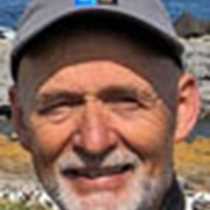Northeastern Svalbard
This day turned out to be the holiday on ice! However, the start was rather uncertain, with dense fog over calm seas. The fog gave no more than three cables of visibility (3/10 of a mile).
The early risers got up as National Geographic Explorer had just crossed 81 degrees north. We had been sailing continuously through open waters since our arrival in Longyearbyen, so our plan was to push northwards to find pack ice, whatever it might take. Pack ice is the true habitat of the polar bear. At 81„a 08.3’ north, pack ice appeared in the mist! At first, with a number of eager spotters on the bridge, we nosed into the ice looking for yellow-white furry creatures…. Just after seven o´clock Ian Bullock caught sight of a polar bear in the foggy distance. A closer look revealed a bear feeding on a bearded seal carcass. One ivory gull and a glaucous gull stood patiently awaiting their turn. What a start of another exploration day in the high north! A few minutes later Captain Leif Skog spotted another polar bear, some five hundred yards from the ship. After breakfast Peter Carey gave a talk on “The walkers and floe rats - the seals of Svalbard” (which he also described as “the bear snacks” of the archipelago). Both the bearded seal and the ringed seal are an important food source for the polar bear, unlike walrus which no sensible bear would dream of attacking. Just as Peter was about to finish his lecture, expedition leader Bud Lehnhausen announced a third bear, which proved to be a huge male, approximately two hundred yards ahead. We were allowed no rest this morning! After lunch many guests headed for a nap. But within minutes, more – not only one or two, but five - polar bears popped up, all in a fairly limited area. Just like the fog, every idea of a well-deserved break had evaporated!
Two interesting lectures were presented during the afternoon. National Geographic Explorer-in-residence, Spencer Wells, who has for many years worked on the human genome, gave a fascinating talk on “Deep ancestry inside the Genographic Project.”
At tea-time the galley celebrated our ice holiday by serving pitta bread with a delicious barbecue on the aft deck. Just afterwards, the polar bear was the topic of the third talk this day, presented by Magnus Forsberg. As this morning alone, we had observed 8 bears, this was a very relevant topic! Magnus explained that the polar bears in Svalbard are part of a subpopulation covering Svalbard, Novaya Zemlya and Franz Josef Land. This population is estimated at 2000-3500 animals. Polar bears prefer to stay near the edge of the ice, because that is where the seals are. Indeed, we followed the ice edge the entire day, until we reached Sjuøyane (Seven Islands). As dinner was served, we passed Rossøya, the northernmost piece of land within Svalbard (74 to 81„a N). The most remote extremes of our Arctic expedition now lie behind us, after a truly grand day.




